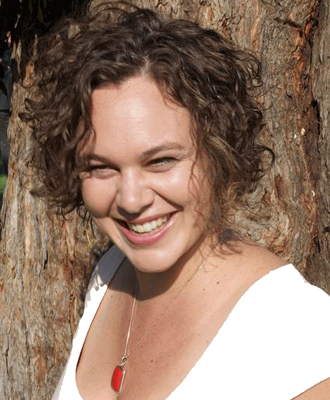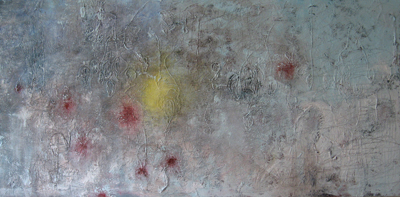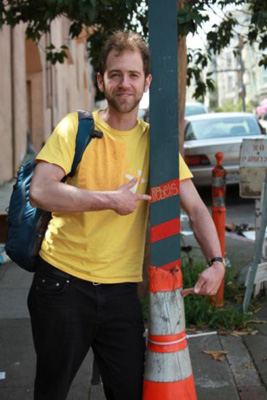Interviews
A Stabbing Out Of the Darkness: Jay Morritt in Conversation with Jessica Hiemstra-van der Horst
 Jessica Hiemstra-van der Horst talks with Malahat volunteer Jay Morritt about "How to bury a yellow toque" (#174, Spring 2011), winner of The Malahat Review's 2011 Open Season Awards in the creative non-fiction category.
Jessica Hiemstra-van der Horst talks with Malahat volunteer Jay Morritt about "How to bury a yellow toque" (#174, Spring 2011), winner of The Malahat Review's 2011 Open Season Awards in the creative non-fiction category.In addition to writing CNF, you are a poet and a painter. How do you balance your several disciplines? How do they inform each other?
I make an effort to resist building fences between my poetry, visual art and prose – and instead tend to think of them as different mediums. In my experience, some propositions work better with line breaks and others work better with paint or string or an HB pencil. Maybe it’s like singing, talking, humming – one voice, one person – but different sounds for different circumstances. There’s a Marc Chagall quote: “I work in whatever medium likes me at the moment.” That makes a lot of sense to me. Maybe it makes more sense to say that I don’t balance the mediums but rather balance myself through them.
How do they inform each other? I tend to work simultaneously on my different writing and visual art projects. I suppose that if each medium is a different expression of the same voice, when they’re in conversation, interesting things get said.
Regarding the search for hope, the narrator in “How to bury a yellow toque” says "[T]hat's out of vogue too. Or at least it seems so." Later on, near the end, she asserts "It's stabs in the dark that are worthwhile." Do you consider making art to be a kind of resistance against despair? Do you believe art practice is an important "stab in the dark" to perform within a culture that might be losing hope?
To answer your first question: yes. I believe that the act of making something is an act of hope. And hope, while not the opposite of despair, resists it. So, if we can make art, if we can write, there’s hope. I’m re-reading Reading Lolita in Tehran at the moment and I’ve been spending time noodling around the web being inspired by Azar Nafisi’s words in any format I can find them. What she has to say about literature comes close to my experience of art – both the experience of engaging with the art other people make and the experience of making it myself. She says “For me, literature is like blood in your veins, but if it stops running in the veins, life stops... ever since I was a kid, literature was a place I would go where the life I could not control would become controllable. I think literature is a resistance against both the tyranny of time and of man.” I think art gives us a safe space to reflect or resist. It offers ethics and, like compassion or generosity, it is a gift and a risk from the artist – an act that is worth it even if the outcome is unknown, or because the outcome is unknown.
I make art because I have to. I’m convinced that art is proof that we haven’t lost hope. The fact that we’re making it means we’re alert – engaging and interrogating how we can be in relationship with each other and our circumstances. As Jeanette Winterson puts it (in Art Objects), “The reality of art is the reality of the imagination. A culture that has lost hope is one that is too tired to imagine." Art makes room for us to imagine. I don’t think Canadians are too tired to imagine. In fact, if you look at what we're making, I’d say we’re wide awake and full of hope, even if we’re uncertain.

I feel there is a significant difference between a “stab in the dark” and “stabs in the dark,” by the way. When I think of swamp lanterns, or art-making in difficult times, I think of a visible and deliberate puncturing of darkness. It’s a stabbing out of the darkness rather than into it. It’s risky but not blind.
[Image: How to bury a yellow toque; Jessica Hiemstra-van der Horst; Acrylic on swamp lanterns]
How crucial is it to you to address the tension between the everyday and the extraordinary in your work?
I think a lot of my work is catalysed by this tension – the apparent tension between the “ordinary” and the “extraordinary.” A significant difference between the mundane and the extraordinary is, simply, frequency. We perceive things to be less extraordinary if they become background noise. We’ve gotten used to planes and the internet and mangoes on shelves. These things have become the daily noise of many of our lives: we consider them to be mundane, despite the fact that what they are – the facts and constraints of their existence – is extraordinary. As it happens, I’m answering your questions in the Ramada in Seoul following a day spent watching movies on the back of a chair after having a Korean flight attendant show me how to eat Korean food 12 kilometres from the ground at 800 kilometres an hour. That’s extraordinary, even though I acted like it was perfectly normal. So, the first thing that intrigues me is how the ordinary is often extraordinary. The mundane is our physical world (it means “earthly”) and it is the extraordinary substance of our lives.
Cataclysm is a whole other kettle of fish. While there are cases where cataclysm is mundane (some people do live in terror), most of us rarely face it. When we do, we experience it as “other-worldly” and struggle to make room for it amongst the rummage of the rest of our lives. This is an important struggle, or juxtaposition.
Juxtaposition is generative. When two unlike things are placed side by side, friction happens. I’m intrigued by this friction. I make art because of it, because I want to know why and how I feel joy in a world of atrocity. The fact is there are mangoes and there is bloodshed. The world is both of these things – so I want to acknowledge them both and see what happens when they resist and support each other, see how much weight they have when they are in the same room, the same poem. Somehow, they are bound up in each other – this is a comfort to me – and it’s also completely perplexing.
Going further into exploring the tensions in your story, the swamp lanterns, which look so beautiful to the narrator but smell so awful, stand as the predominant symbol for the inseparability of light and darkness. This unity between the negative and the positive seems, to me at least, to be at the heart of what you are trying to grapple with in “How to bury a yellow toque.” How, if at all, do you address this theme in your poetry? Your painting?
I’m interested in the idea that we are defined by the space around us – that, physically, the world makes room for us instead of us making room for ourselves in the world. I think in “Western culture” we have a habit of looking inward to figure out our shape. I like the idea of subverting this – of pressing up against the things around me and listening to them until there is enough contrast for me to feel like I have a shape, that my experience has some sort of definition. The thing is, we need contrast in order to see – both metaphorically and physically. We exist in relationship.
I think I write so I can discern my profile within a particular experience or context. I think painting for me is less about articulating that experience and more about walking around in it – trying it on, sharing it. Perhaps when I paint I sort something out with my body and when I write I sort something out with my mind (though I don’t think it’s such a neat binary). Some days I wonder if my painting and my writing are a positive and a negative space – if they need each other in order to be seen. They certainly do articulate each other.
In your story, you draw heavily on your relationships with your family. What roles do connection to family and community play in your art practice?
There is no art without community is there? I think that any attempt to separate ourselves from our community, our family (however we choose to define it), will fail. The people in our lives are part of our lives. They create our profile, give us our voice, or at least give us an urgency to speak. Just as negative and positive spaces are bound up in each other, we are bound up in community. In fact, for artists and writers, what we have to say is not visible or audible without a community to engage with it.
I grew up encouraged to make things. Art was a value in my childhood. My mother is a storyteller and my father is a potter. I have always had supportive friends. This translates into my willingness to take risks, which is a gift (at least for me!). My community of family and friends give me the confidence to make my “stabs in the dark.” I guess what my supporting community does is give me enough hubris to begin without being too afraid of all the obstacles I will inevitably encounter – and then I get lost in the work – and have to find my way out.
Okay, finally, a less philosophical, more "here's your chance to put in a plug" type question: What are you working on now? What's on the creative horizon for you?
Not surprisingly, I’m all over the map (and not just literally).
My first full-length collection of poems, Apologetic for Joy is going to be published by Goose Lane in the fall.
I’m also co-editing, with Lisa Martin-DeMoor, a collection of Non Fiction essays for an anthology called How to expect what you’re not expecting (howtoexpect@gmail.com) to which this essay will belong. We hope to begin soliciting in earnest soon for well-crafted essays by intelligent writers about any aspect of pregnancy, loss, and/or parenthood that they did not expect to encounter.We’re hoping to put something together that’s both artful and engaged – in the tradition of Joan Didion or Annie Dillard. When my sister’s baby died a few years ago, I scrambled to find something to give her that would be useful. The best I could come up with was Stephen King’s Dark Tower series. Not to knock the series – it was a great place for her to go – but I would have liked to have given my sister stories that were closer to her experience, stories that might have even offered her some solidarity, even community.
What’s on my immediate horizon, however, is a move to Sierra Leone – a move I’m in the midst of as I write this. I’ll be there for most of 2011. I’m writing a novel (with my mother) that’s “nearly done” and I’d like it to be “almost done” or (even better) “actually done” by the end of the year. I’m also working on another book of poems (Waltzing with Atomic Tangerine) that I hope to make ship-shape while I’m there. I have plans for art too. They involve making paper and making some short animated films with drawings – but I don’t want to say too much because my art plans are still germinating. I anticipate that my time in Sierra Leone will be a fruitful one – it’s one of my favourite places in the world (I lived there as a child). By the time this interview will be published, I’ll be sipping a Star beer on the beach, hopefully clacking away on my trusty notebook.

Jay Morritt
* * * * * * * * *
Check out the guidelines for our 2012 Open Season Awards.









